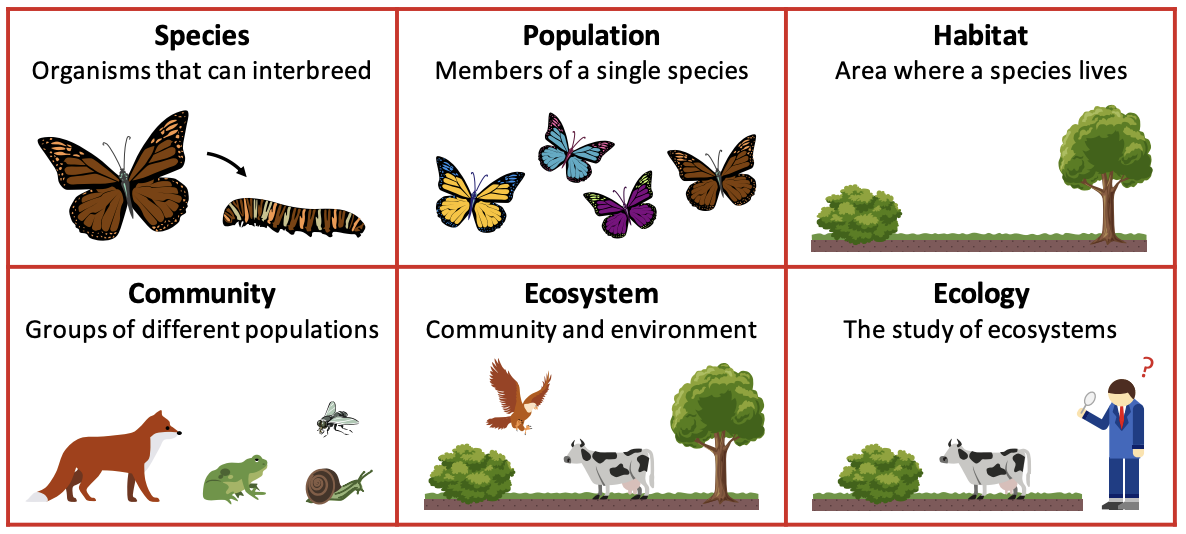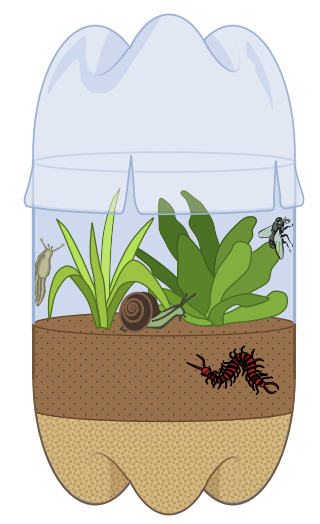4.1 Species, Communities and Ecosystems
0.0(0)
Card Sorting
1/18
There's no tags or description
Looks like no tags are added yet.
Study Analytics
Name | Mastery | Learn | Test | Matching | Spaced |
|---|
No study sessions yet.
19 Terms
1
New cards
What does Ecology studies?
Studies how **living things interact** with each other and the environment
2
New cards
Biotic factors
**Living conditions** that affect **organism survival.**
* Include sources of competition (intra-specific / inter-specific) and predators
* Include sources of competition (intra-specific / inter-specific) and predators
3
New cards
Abiotic factors
**Non-living** conditions that affect **organism survival.**
* Temperature, availability of light or rain, levels of pollution, etc.
* Temperature, availability of light or rain, levels of pollution, etc.
4
New cards
Species
Groups of organisms that **interbreed** to produce **fertile, viable offspring.**
* **Hybrid** species are the **infertile** offspring of two distinct species (e.g. mules)
* **Hybrid** species are the **infertile** offspring of two distinct species (e.g. mules)

5
New cards
Populations
Groups of organisms of the **same species** living in the **same area** at the **same time**
* e.g. populations of squid and crabs within an aquatic ecosystem.
* e.g. populations of squid and crabs within an aquatic ecosystem.

6
New cards
Community
Groups of populations of **different** species that **live within a given area and** __**interact.**__
* The environment in which a species lives (its normal location) is called a **habitat.**
* The environment in which a species lives (its normal location) is called a **habitat.**

7
New cards
Ecology Terms: **Ecosystem**
**All** of the **communities** within a given **environmental region.**
* It is composed of both __biotic__ factors (communities) and __abiotic__ factors (habitat).
* It is composed of both __biotic__ factors (communities) and __abiotic__ factors (habitat).

8
New cards
Summary of Ecology Terms

9
New cards
Nutrition
Uptake of both **energy** and materials from **environmental sources**.
* It occurs via an **autotrophic** (self source) or **heterotrophic** (other source) method.
Some organisms may use **both** forms of nutrition according to need (mixotrophs)
* It occurs via an **autotrophic** (self source) or **heterotrophic** (other source) method.
Some organisms may use **both** forms of nutrition according to need (mixotrophs)
10
New cards
Autotrophs
**Synthesize** organic molecules (food) from simple inorganic substances.
* As they are making their **own organic compounds**, they are called ==__**producers**__==.
Inorganic nutrients needed for this process are obtained from **air, water and soil**.
* Most will derive the required energy from **sunlight** ***(photosynthesis)****.*
* Some from inorganic redox reactions ***(chemosynthesis).***
* As they are making their **own organic compounds**, they are called ==__**producers**__==.
Inorganic nutrients needed for this process are obtained from **air, water and soil**.
* Most will derive the required energy from **sunlight** ***(photosynthesis)****.*
* Some from inorganic redox reactions ***(chemosynthesis).***

11
New cards
Heterotrophs
Obtain organic molecules from other organisms via acts of **feeding**.
* This organic material is originally synthesized by autotrophs (*i.e. the producers*)
* This organic material is originally synthesized by autotrophs (*i.e. the producers*)
12
New cards
How are heterotrophs classified?
According to their feeding pattern.
* **Consumers**
* **Detritivores**
* **Saprotrophs**
* **Scavengers**
* **Consumers**
* **Detritivores**
* **Saprotrophs**
* **Scavengers**
13
New cards
Heterotrophs: Consumers
Ingest **organic matter from living** (or recently killed) organisms.
* Herbivores = plant matter.
* Carnivores = animal matter.
* Omnivores = both
* Herbivores = plant matter.
* Carnivores = animal matter.
* Omnivores = both

14
New cards
Heterotrophs: Detritivores
Obtain nutrients from **non-living organic material** (i.e. detritus, which is a waste of any kind).
* Detritus may include **fecal material** or decaying leaf litter in the soil (humus).
* Detritus may include **fecal material** or decaying leaf litter in the soil (humus).

15
New cards
Heterotrophs: Saprotrophs
Obtain organic nutrients from **dead organisms** by external digestion (they are *decomposers*)

16
New cards
Heterotrophs: Scavengers
Feed on decaying biomass (i.e. carrion)
17
New cards
Closed Ecosystems
Two conditions for the **sustainability** of an ecosystem:
* **Energy influx** – sunlight provides **initial energy** **source** for most communities.
* **Nutrient cycling** – **saprotrophic decomposers** recycle nutrients in ecosystems.
* **Energy influx** – sunlight provides **initial energy** **source** for most communities.
* **Nutrient cycling** – **saprotrophic decomposers** recycle nutrients in ecosystems.

18
New cards
Mesocosm
**Enclosed** environments that allow a small part of a natural environment to be **observed** under ^^**controlled conditions**^^ (e.g. sealed terrariums)

19
New cards
Ecological Measurements
Biotic conditions (e.g. species distribution) in __open ecosystems__ can be measured
* **Quadrats**: **rectangular** frames of known dimensions (used for *sampling*).
* **Transects**: **straight** lines along a defined abiotic gradient (*elevation*)
* **Quadrats**: **rectangular** frames of known dimensions (used for *sampling*).
* **Transects**: **straight** lines along a defined abiotic gradient (*elevation*)
